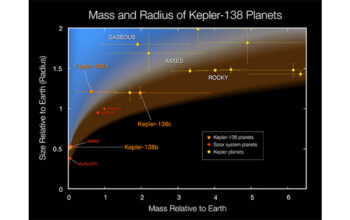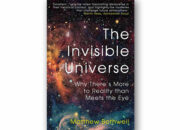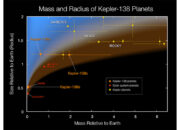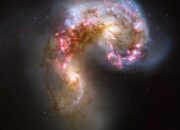The quest for understanding the cosmos has long captivated humanity’s imagination, facilitating profound advancements in the realm of astrophysics. Among these explorations lies the discovery of the most distant galaxy ever observed, an astronomical finding that has not only revolutionized our understanding of the universe’s structure and evolution but also evoked an insatiable curiosity regarding the formation of galaxies in the early cosmic epochs. This article delves into the intricacies of this extraordinary galaxy, providing a detailed overview of its significance and the implications of its discovery.
Galaxies serve as the fundamental building blocks of the universe, containing stars, stellar remnants, interstellar gas, dark matter, and dust. Typically, galaxies form through gravitational interactions and mergers over billions of years. However, the emergence of the most distant galaxy represents a unique window into the primordial conditions of our universe, offering insights into a formative era approximately 13.4 billion years ago, just 400 million years following the Big Bang.
The galaxy in question, known as GN-z11, was detected utilizing the capabilities of the Hubble Space Telescope and later refined through observations made by the Keck Observatory in Hawaii. GN-z11 resides at a staggering redshift of 11.09, which correlates to its position at an extraordinary distance of roughly 13.4 billion light-years from Earth. This significant redshift indicates that the light we observe today has been traveling to us since the early stages of cosmic history. Essentially, observing GN-z11 is akin to looking back in time, enabling astronomers to study the conditions of the universe when its formation was still in its infancy.
The discovery of GN-z11 is pivotal for several reasons. Firstly, it challenges prevailing notions about the formation of galaxies. Prior to this finding, it was posited that galaxies formed slowly over extensive time scales. However, the presence of GN-z11 suggests that rapid evolutionary processes may have been at play during the universe’s early epochs. The sheer size and luminosity of this galaxy imply that it harbored a substantial number of stars formed in a brief span of time. Such a conclusion compels astrophysicists to reevaluate models concerning the rate of star formation and galaxy assembly during the formative years of the universe.
Moreover, the composition of GN-z11 offers tantalizing implications about the initial conditions of matter in the cosmos. Spectroscopic analysis reveals that this galaxy has a stellar mass comparable to that of the Milky Way, despite being light-years away from our own; this suggests a richer and more complex structure of matter in the early universe than previously understood. The ability to detect such a massive galaxy at a distance vastly beyond any earlier observations implies that the mechanisms driving galaxy formation and growth were already well established shortly after the Big Bang.
Interestingly, GN-z11 also showcases an unusually high star formation rate. Observations indicate that this galaxy spans a mere 1,600 light-years in diameter yet produces stars at a rate exceeding that of our galaxy today by a factor of over ten. This observation posits the hypothesis that young, rapidly forming galaxies like GN-z11 may have been more prevalent in the universe’s early history than current models can adequately explain. Such findings compel the scientific community to investigate the role of gas cooling, feedback mechanisms, and other astrophysical factors that could enable such vigorous rates of star formation.
The study of distant galaxies such as GN-z11 is intrinsically linked to our understanding of dark matter. The elusive nature of dark matter continues to fuel scientific inquiry, as its presence is inferred through gravitational effects in visible matter and cosmic structure formation. The observations of GN-z11 contribute to theoretical frameworks positing the existence of dark matter, affecting both the structure of galaxies and the cosmic-large scale structure. As researchers continue to map the nature of dark matter and its role in galaxy evolution, discoveries like GN-z11 become instrumental in unraveling these cosmic enigmas.
Additionally, GN-z11’s discovery illuminates the limitations faced by current telescopic technologies and emphasizes the potential for future astronomical observations. The advent of advanced telescopes, such as the James Webb Space Telescope, promises to expand the horizons of our understanding even further. As this new generation of observational tools becomes operational, it will allow scientists to probe deeper into the universe’s history, unveiling a plethora of distant galaxies yet to be discovered. This prospect engenders a compelling shift in perspective regarding the temporal and spatial scales of cosmic existence.
As humanity continues its exploration of the cosmos, the study of galaxies such as GN-z11 prompts profound philosophical considerations about our place within the universe. The capacity to observe and decipher light from the most distant reaches of space not only reflects our technological prowess but also enriches our existential understanding of cosmic evolution. The triumphs of astrophysics invite curiosity, urging a relentless pursuit of knowledge about not just distant galaxies, but the fundamental mechanics governing the entire universe.
In summary, the discovery of the most distant galaxy, GN-z11, marks a watershed moment in cosmological research, challenging existing paradigms and invigorating scientific inquiry. Its unique attributes compel a reexamination of how galaxies form and evolve and present opportunities to deepen our understanding of dark matter’s influence and the universe’s overarching structure. As research progresses, it holds the promise of bridge-building between epochs, connecting modern observations with the primordial tapestry of the universe. It is an exciting time in astrophysics, revealing the vast potential that still remains within the celestial realm, eager to be unveiled by human curiosity and intellect.










